Book Review: “Salt Sugar Fat” by Michael Moss
The only way out of the fast-food dilemma is to do it yourself. Only a relative few with the necessary financial resources manage to do this.
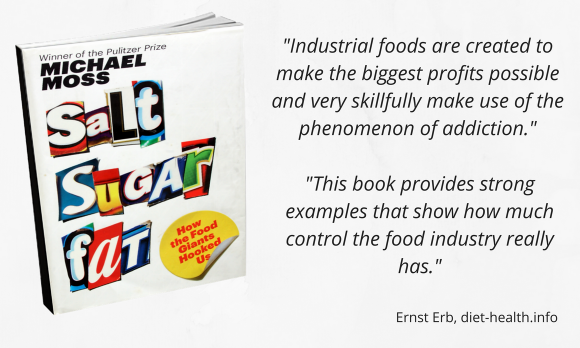
Table of contents
- Conclusion
- 1. Summary
- 2. Book review
- SUGAR
- 2.1. Exploiting the Biology of the Child (p. 3)
- 2.2. How Do You Get People to Crave? (p. 25)
- 2.3. Convenience with a Capital "C" (p. 45)
- 2.4. Is it Cereal or Candy? (p. 68)
- 2.5. I Want to See a Lot of Body Bags (p. 95)
- 2.6. A Burst of Fruity Aroma (p. 121)
- FAT
- 2.7. That Gooey, Sticky Mouthfeel (p. 145)
- 2.8. Liquid Gold (p. 160)
- 2.9. Lunchtime Is All Yours (p. 182)
- 2.10. The Message the Government Conveys (p. 212)
- 2.11. No Sugar, No Fat, No Sales (p. 236)
- SALT
- 2.12. People Love Salt (p. 267)
- 2.13. The Same Great Salty Taste Your Customers Crave
- 2.14. I Feel So Sorry for the Public (p. 302)
- 2.15. We're Hooked on Inexpensive Food (p. 331)
- 3. Food industry and consumers (my own thoughts on the subject)
- 4. About the book
Conclusion
The only way out of the fast-food dilemma is to do it yourself. And the only people who manage this are those who live a natural lifestyle and an intelligent minority who have the necessary financial means.
Junk food is very cheap, available almost everywhere, requires very little or no preparation, and is an especially quick and easy option for meals.
Moss, other journalists, and a number of scientists have predicted that the future will bring catastrophic health care costs. And as long as these don't have a noticeable impact, no effective measures will be taken. Political involvement is to blame here.
See the section The Secret Meeting in 1999, which is a MUST-READ if you want to understand this dilemma. For readers who are interested in learning more about the topic, I have included links to Wikipedia. There, you will find a lot of interesting and helpful information. Often, the pages are only available in English as pages in languages other than English are often created by individuals whose opinions are influenced by specific industries.
1. Summary
Many people assume that the topic of food safety is well regulated by the government. This book provides compelling examples that show how much control the food industry really has. As a result, there are many places where laws to protect consumers are lacking. The food industry has an increasing say here.
About the author and personal comments
Michael Moss received a Pulitzer Prize in 2010 in the category Explanatory Reporting. Before this, he had been a finalist on two occasions. While writing the book, he worked as a journalist for The New York Times. He also received the Gerald Loeb Award for Food Safety (under the category Work) and a commendation from the Overseas Press Club (OPC). Here are links to the OPC and the OPC of America websites. Moss also taught as an adjunct professor at Columbia School of Journalism.
Michael Moss also wrote:
- the book Palace Coup,
- the article The Extraordinary Science of Addictive Junk Food, which appeared in the magazine section of The New York Times,
- and a blog in The Huffington Post under the title Sugar Salt Fat.

Several years before Salt Sugar Fat appeared, the German book Lügen Lobbies Lebensmittel (Lies lobbies food) was published. This book focuses primarily on the situation in Europe. Please click on the link to go to the book review (currently only in German).
The images that I have added to this book review serve to break up the text and provide space for additional comments. The book Salt Sugar Fat itself doesn't contain any images. The images here are either from Wikipedia, from the public domain, or I took them myself. Entries on Wikipedia often lack objectivity. Representatives of specific industries also write many articles, and an account from the opposing point of view is often not possible.
You can enlarge each of the images by clicking on them—and also view all of the images as a slideshow.
After the prologue title “The Company Jewels,” there are three sections to the book: Sugar (6 chapters), Fat (5 chapters), and Salt (3 chapters).
The order of the topics is not the same as the title. There is an epilogue on page 331 titled “We're Hooked on Inexpensive Food.” And as is common in US books, numerous acknowledgments (starting on p. 349), information about the sources (starting on p. 353), and notes (starting on p. 357) are included. And then there is a selected bibliography starting on page 417 and a topical index from pages 423–446.
The fact that the liberal idea of “Everybody is responsible for themselves” is not true for a majority of the population can be seen in society itself.
Readers shouldn't expect a nonfiction book that works carefully with a purely factual common theme, but rather more of a novel. In the book, we see that time, places, and facts are all woven together—somewhat like with a stew.
Salt Sugar Fat is the best book that I have yet to read about the problems of popular convenience foods (including pizza) and industrially produced foods.
For those who avoid these types of foods, this book will serve as a confirmation. Unfortunately, those who are affected usually don't read this type of book. But if so, they should expect a difficult struggle with their own emotional brain or rather limbic system and amygdalae (emotional reactions). Most people unfortunately develop a sense of resignation—before they would try to take their fate into their own hands.
Moss offers an impressive explanation of how the brain responds to stimuli. Industrial foods are created to make the biggest profits possible and very skillfully make use of the phenomenon of addiction. He describes studies with salt that show how programming errors are already possible in the mother's womb and in the first months after birth. But it is also possible for us to get out of this cycle, as the study described below shows. However, this takes three months and requires a lot of willpower.
 | Der Spiegel (German magazine) covered this topic in issue 10/2013 with the cover story "Die Suchtmacher" (Addictive fast food) and on the Internet under the title "Die Menschen-Mäster" (Fattening up people) and subtitle "The food industry uses a lot of fat, salt, and sugar to make its products attractive and its customers addicted. Critics compare the health risks of greedy appetites with the risks of alcohol and tobacco." See also Lebensmittelklarheit.de (German only). |
Addictive fast food
The article also discusses the traffic-light labeling system, which was successfully introduced in the UK. This system requires that there be a red, yellow, or green light next to the list of ingredients.
The German politician Ilse Aigner positioned herself against this type of solution. Instead, she wanted the EU to work on the problem. However, associations and multinational companies bombarded the politicians with calls, emails, and position papers and won.
The European Interessenverband Lebensmittelindustrie (food industry association) is believed to have spent a billion euros on this campaign.
Those who have analyzed the numbers in the past several years and calculated for the future know what society is going to be faced with. The facts are now on the table. It isn't eating disorders that are the problem here, but rather the masses of people who have poor eating habits. Most people lack information, education, and financial resources.
In February 2013, principal investigator Robert Moodie published the following statement in the scientific journal The Lancet. Moodie teaches at the University of Melbourne in Australia.
Corrective laws and measures are lacking. Given the corruption in the food industry and politics, such laws are not yet possible. Personal suffering and health care costs will have to first increase much further.
Personal comments
I read this book on April 19, 2013, when our plane from Richmond to Dallas had to return to the airport because of a burning smell and we were stuck in the airport for a day. What a coincidence! My wife and I had stayed in 40 different places in the US and talked with a lot of people.
After this, I decided that I wanted to dedicate myself to this educational work of promoting a life full of activity and health. And I wanted to do this even though numerous publications on the topic existed because these were often too one-sided, incomplete, or even misleading.
With Salt Sugar Fat, I think it would have been better if Moss had dealt with all of the stories about and around the companies and the people separately and had followed a chronological order or selected a certain subject area to focus on. Options would have been, for example, the topics of politics and influence, the companies themselves, the effects of certain ingredients as determined by research, products, consumers, their needs and desires, or aspects to consider for the future.
The author was not even able to really separate the chapters Salt, Sugar, and Fat. I think that too much is woven together. And this makes it difficult to summarize the content of the book.
But despite the high level of complexity, the book is very interesting and gives the reader deep insight into the seducers and the seduced. We see that even the seducers are also seduced, thanks to their human character. They are responsible, either unscrupulously, unconsciously, or consciously, for causing an entire society to have major health problems.
2. Book review
Michael Moss begins his book with a description of the extraordinary secret meeting on April 8, 1999, where the most important top managers (CEOs) of the food industry giants met. One of these 11 men supervised a total of 700'000 employees and annual sales of $280 billion.
After the prologue, Moss uses the three book sections to explain the role of sugar, fat, and salt and why, for example, the food industry has to use these and other additives in order to achieve the necessary shelf life—and to capture market share.
In certain sections, Moss describes the industry's actions in the areas of research, development, production, marketing, and sales in detail. For this book, he spoke with numerous persons who are or were in positions of responsibility and with government and public officials. With in-depth insider knowledge, Moss was able to report on the dilemma that concerns us all.
The “nature of humans” and other books on the subject
My opinion is that we recognize how such a catastrophe can happen, albeit unwanted, but foreseeable; this is just our human nature. Reliable corrective measures are lacking in certain areas. But society will only put these in place if something leads to a major disaster.
There isn't a conspiracy in progress. The “nature of humans” is simply having an effect. This nature is something that idealistic politicians don't recognize. True liberalism is really the opposite of communism, but if the concentration of power is too large, the results are very similar.
I would recommend this interesting book to every person. You will find several stories about incidents, links, and consequences. Unfortunately, the book lacks a certain structure that could better guide the reader.
- It should be noted that the industry critic Kelly D. Brownell mentioned in this book review published the book Food Fight: The Inside Story of the Food Industry, America’s Obesity Crisis, & What We Can Do About It (McGraw-Hill, 352 pages) in August 2003 (paperback edition: 2004). The coauthor is Katherine Battle Horgen. The book received much less recognition than "Salt Sugar Fat".
- And also the book Appetite for Profit: How the Food Industry Undermines Our Health and How to Fight Back by Michele Simon didn't achieve near the success (2006, Nation Books, 416 pages).
- And not long before "Salt Sugar Fat" by Moss, other books on the subject appeared, but they didn't enjoy the same large response and recognition. An example is Food Politics: How the Food Industry Influences Nutrition, and Health, revised and expanded edition by Dr. Marion Nestle (University of California Press, October 2007, 510 pages).
The large number of similar books does point to the fact that at least for interested groups this is a hot topic.
The Secret Meeting in 1999
James Behnke, who was 55 at the time and a special advisor to Pillsbury's chief executive, organized this meeting. He suspected that the US government would intervene and do something about the ever increasing problem of obesity in the population. He also feared that the government would blame the food industry for the growing health care crisis.
At this meeting, there were no agenda items, notes, or journalists. The CEO of each of the following eight companies took part: Nabisco, Kraft, General Mills, Procter & Gamble, Coca-Cola, Mars, Pillsbury, and Nestlé. As competitors, these food industry giants fought hard and still fight hard today on the market. That same year, General Mills acquired the major cereal producer Kellogg.
The CEOs from the two most important suppliers were also present. These are Cargill (United States), a family company with $134 billion in annual sales that is responsible for the purchase, processing, and sales of grains and grain products, and Tate & Lyle (UK).
John Cady from the National Food Processors Association (NFPA) arrived only in time to take part in the dinner together. Note: The NFPA is now called the Food Products Association (FPA).
Tate & Lyle's sucralose business has belonged to the American Sugar Refining Company since 2010.
Sucralose
Sucralose is the brand name for trichlorogalactosucrose and is about 600 times sweeter than sugar or to be precise granulated sugar (sucrose), but it doesn't have any calories.
It has been authorized in Canada since 1991, the US since 1999, and the EU since 2004.
This sugar substitute is already present in many foods as food additive E955.
The acceptable daily intake (ADI) is 15 mg per kg of body weight. Certain additives do not have to be labeled with E numbers. And some of these have not undergone adequate research in regards to adverse effects.
 | See, for example, dispersants, thickening agents (usually as E numbers), and emulsifiers—see also additional additives. |
James Behnke, PhD in chemistry, had a successful career at Pillsbury for several years and was appointed special advisor to the CEO in 1999. He proved to have great ability to see the increasing health problems. He recognized that the industry was causing the dilemma. The industry assumed that several of their products would be eaten occasionally, but the competition caused these products to become so cheap that they took front and center stage. In addition, the industry determined a bliss point that really makes consumers want to have more.
Procter & Gamble, Mars Incorporated, Kraft and Pillsbury Company
Procter & Gamble (P&G, US), founded in 1837, is a multinational company for consumer products. P&G is a leader in brand management, but is a company that hardly comes into the public eye although it practically invented radio advertising as well as television advertising early on as marketing instruments.
P&G also sponsored and produced modern communication strategies such as radio and television shows, including Guiding Light, 1937 to 2009, which was the longest-running soap opera (Guinness Book). The German television station RTL produced parts of the story from 1986 to 1999.
Coca-Cola is the world's largest soft drink company and one of the most well-known brands in the world. Asa Griggs Candler acquired the rights from inventor John Stith Pemberton (1831–1888) and founded the Coca-Cola Company in 1892.
We know Mars Incorporated from the popular Mars chocolate bar. Frank C. Mars, together with his wife, began to produce sweets in 1911 and founded the company Mar-O-Bar in 1920.
Frank then changed the name to Mars Incorporated (US) in 1922 and introduced the Milky Way candy bar in 1923. His son, Forrest E. Mars, introduced the Mars bar in England in 1932. In 2010, the company had annual sales of $28 billion and 65 thousand employees. Forbes Magazine listed Mars in 2010 as the fifth largest private company in the US. It was listed on the stock exchange in Switzerland, but not in the US.
Today, Nabisco (US) belongs to Kraft, which is now divided into Kraft Foods Group (US) and Mondelēz International (US). Today, Mondelēz International is the third largest food company in the world after Nestlé (Switzerland) and PepsiCo (US). Nestlé S.A. is the largest food company in the world. In 2011, its annual sales were approximately $90 billion, and the company had 330 thousand employees. Henri Nestlé (1814–1890) founded the company in 1866 and introduced a milk powder for infants in 1867. In 1875, he sold his successful company to his business associates (as per Wikipedia, May 2015)—Nestle himself only talks about selling to Pierre-Samuel Roussy, his flour supplier.
At that time, the Pillsbury Company was one of the multinational beverage producers for beer and whiskey (Diageo plc is the largest today). The majority of the British Distiller's Company's (DCBL) assets, (Conteran license holder) are now a part of Diageo plc.
Since 2001, Pillsbury has belonged to General Mills, which was founded in 1866 and had annual sales of $16.7 billion in 2012. General Mills is best known for its breakfast cereals.
Moss writes that the company introduced a new form of marketing in 1932 with its daily soap opera Betty and Bob on the radio station NBC.
According to Wikipedia, the first market players were the Dial Corporation (subsidiary of the Henkel Group), Proctor & Gamble, Colgate-Palmolive, and Lever Brothers.
Irma Phillips created this genre with Painted Dreams, the first daily soap opera that premiered in October 1930.
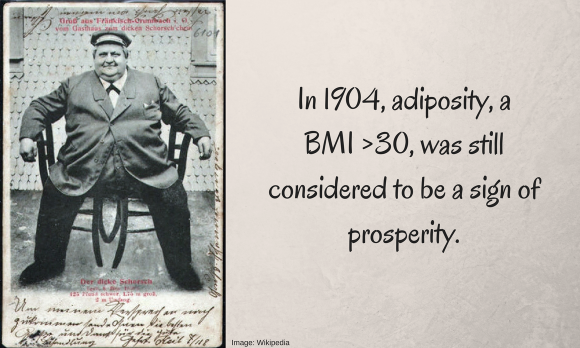
Michael Mudd, who at the time was the vice-president of Kraft, explained that huge numbers of young people in the United States were overweight. And that not doing anything about this problem would be a big mistake because it would come back to hurt the companies, he believed.
Overweight and obesity
He stated that more than half of the adults in the US were overweight. And that of these, 40 million were obese (obesity: a BMI of >30).
The number of children who were overweight had more than doubled between 1980 and 1999. And 12 million children were obese.
Mudd explained that the social costs were huge at between $40 to 100 billion a year. He also showed the drastic increase of diseases such as diabetes mellitus, coronary heart disease, arteriosclerosis, heart attacks, arterial hypertension (commonly known as high blood pressure), bile and liver problems, osteoarthritis, breast cancer, colorectal cancer (colon cancer), and endometrial cancer.

Today, obesity is a global problem. Even in China, people have adopted our foods and eating habits. In comparison to the West, China still has lower numbers when it comes to true obesity, which is a BMI >30.
The Wikipedia entry on obesity (German version) includes a bar graph from 2005 on obesity in 30 countries (doesn't include China).
It shows that 3.2 % of the population is obese in Japan and Korea, followed by 7.7 % in Switzerland and then 9.1 % in Austria (position 6) and 12.9 % in Germany (17).
The countries at the top with more than 20 % are New Zealand, Australia, Greece, Slovakia, the UK, Mexico (24.2 %), and the United States with 30.6 %. Mexico may soon pass up the US if they haven't done so already.
Mudd included the fact that Walter C. Willett, the chair of Harvard's Department of Nutrition, had been on a PBS Frontline report called “Fat” and had already been pointing to industrial food production as the cause of this obesity epidemic. Among other things, he explained that most grains are converted to starches, sugar is used in a concentrated form, and many foods contain trans fatty acids.
Losing key allies
Mudd emphasized that the food manufacturers were in danger of losing key allies such as the American Heart Association (AHA) and the American Cancer Society (ACS).
He also warned that although the United States Department of Agriculture (USDA) received money from the companies represented, the problem may soon cause the USDA chief to bite the hand that feeds him. The ubiquitous, cheap, very tasty, super-sized, and energy-dense food and beverages were turning the food pyramid recommended by the state upside down.
Mudd warned that Kelly D. Brownell, a well-known critic of the food industry, was pointing out connections to the tobacco industry.
This was problematic because lawyers had imposed large penalties and restrictions upon the cigarette industry. Now, these same lawyers could turn to the problem of obesity.
Next, Mudd presented ways to get around this problem. The industry itself should investigate the links between diet and obesity and put industry-wide limits on salt, sugar, and fat. Mudd also wanted to change the way that products were marketed to children. He then ended by saying that the industry should be part of the solution instead of the problem.
Then all eyes turned to the CEO of General Mills, Stephan W. Sanger (1946-present, previously at Procter & Gamble) as his company was the one that had the most to lose. His particular exploits in supermarkets had impressed the others in the industry. Under his leadership, General Mills had conquered the supermarkets with convenience foods.
"Don't talk to me about nutrition, talk to me about taste!"
Sanger appeared to be very upset and reminded the others that both consumers and their ivory tower advocates were fickle, with what they love and what they eat. Consumers would discuss the topic of sugar, and then of fat and salt, but they usually bought the things they liked the best. Don't talk to me about nutrition
, he said, speaking like a typical consumer.
Talk to me about taste, and if this stuff tastes better, don't run around trying to sell stuff that doesn't taste good (p. xx of prologue).
Besides, he reminded them that the industry had always managed to handle things, for example, negative news about trans fats.
He would move forward and would not pull his employees back. And his peers should do the same. Not everyone in the room shared this position, but it was very comforting. And Sanger presented his views in such a forceful and persuasive manner that they served as the closing words of the meeting.
And later, Sanger still felt his approach was right. He argued that his company also offered healthier versions of their mainline products. But as time went on, these companies manufactured products that contained even more salt, sugar, and fat.
Further pressure from the public and government circles brought about small improvements, which, above all, were urgently needed in foods for children.
The S'more products made by Hershey took the levels of fat, sugar, and salt to new heights. Daryl Brewster, CEO of Nabisco, told Michael Moss that Hershey's move had put them in a position where they were practically forced to add more fat in order to get to the bliss point. This was the only way that Nabisco could regain lost market share.
Food fight
For example, the new slogan in 2011 for the Oreo in India, where the company was securing a new foothold, was “Twist, Lick, Dunk.” Kraft used the slogan “Slam dunk,” which describes both a basket shot and dunking and eating the cookie.
It took numerous interviews and five months of research before Moss was able to put together the story of this secret meeting. He decided to put it at the beginning of his book as it shows typical actions of this largely unbridled industry. The companies demand success at almost any price. People who have concerns about the consequences of this type of diet don't have a place there. A company can't bring itself down.
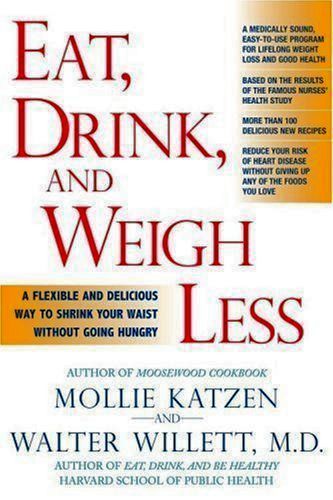 | Walter C. Willett has written several books including "Eat, Drink, and Weigh Less: A Flexible And Delicious Way To Shrink Your Waist Without Going Hungry", which he co-authored with Mollie Katzen. The book is available as a reprint edition from 2007 (307 pages). |
Katzen published her first cookbook, "The Moosewood Cookbook", in 1977. She promotes a vegetarian diet.
Willet also wrote "Eat, Drink, And Be Healthy: The Harvard Medical School Guide to Healthy Eating" (2003). There is a large number of other books available that describe this problem.
Kelly D. Brownell published The LEARN Program for Weight Control: Lifestyle, Exercise, Attitudes, Relationships, Nutrition in 1994 (226 pages). The tenth edition was printed in 2004 as a paperback (226 pages), but it is much too expensive.
Together with Katherine Battle Horgen, Brownell's book Food Fight: The Inside Story of The Food Industry, America’s Obesity Crisis, and What We Can Do About It was published by McGraw-Hill in 2004 as a paperback (356 pages).
Brownell also published additional books, some of which were with co-authors. However, I wouldn't recommend these as they aren't scientific enough.
SUGAR
Based on extensive insider knowledge, Michael Moss explains how the industry researches the proportion of sugar, salt, and fat that needs to be added to a product so that special impulses are triggered in our brain.
2.1. Exploiting the Biology of the Child (p. 3)
The bliss point is different for each person, depending on their age and other factors. Small children require a recipe with significantly more sugar in order to reach their bliss point.
The food industry computes this with cleverly devised studies—primarily conducted at Monell Chemical Senses Center, a nonprofit independent scientific institute.
Gustatory perception
Researchers at Princeton University discovered that rats get chattering teeth when they go back to a normal diet after having been on a sugary diet for a certain period of time (p. 6).

Note: Cats, on the other hand, can't taste sugar as they lack the receptor for sweetness. However, some cats love chocolate as it contains other flavors.
In 2001, researchers at Monell identified the protein molecule TIR3 in the taste buds that detects sweetness. This experience is called gustatory perception.
It wasn't until later that researchers determined that these types of sugar sensors are also present in the digestive tract.
In 2009, the group working under Robert Margolskee discovered that the sweet taste receptors in the brain respond to cannabis (marijuana) because sugar is a chemical sister of THC (tetrahydrocannabinol).
Note: The Wikipedia entry on Monell lists 12 important achievements that have benefited the food industry.
Moss writes that half of Monell's annual budget of $17.5 million comes from taxpayers. The other half comes from donations, but also from specific studies conducted for PepsiCo, Coca-Cola, Kraft, Nestlé, Philip Morris, and other food manufacturers (p. 7).
Monell financed research that would put cigarettes in a more favorable light. Moss also describes tests conducted with children to “determine their bliss point.” These tests have allowed the industry to develop foods that children really crave.
The desire children have for things that are especially sweet
Moss starts his story about sugar with the desire children have for things that are especially sweet. The reason for this is that breast milk is very sweet. Children taste this sweetness from the very first day of their life, whereas they don't have salt until they are between four and six months. And African Americans also have a greater preference for sweeter foods than the average consumer.
Moss explains in great detail how Monell conducts studies with children and adults on a large scale and what findings the food industry gains from these.
Moss acquired the information he needed on this topic by visiting with individual employees at Monell.
Moss explains how refined starches act immediately with the help of amylase and trigger sugar cravings.
Amylase was the first enzyme to be discovered. The chemist Anselme Payen identified it in 1833 and named it diastase.
In the 1980s, the majority recognized that increased consumption of sweet foods can over time cause tooth decay, heart diseases, diabetes, and the like. But authorities were no longer able to appeal to stay-at-home moms since two-thirds of the sugar consumed came from processed foods.
Call for action
US Senators George McGovern, Bob Dole, Walter Mondale, Ted Kennedy, and Hubert Humphrey published a call for action and provided guidelines for a better diet. They received support from Mark Hegste and Michael Jacobson from MIT and from Ralph Nader. They gathered twelve thousand signatures in an attempt to get advertising of sugary foods banned on children's television (p. 17).

Ralph Nader first became popular in 1965 with his book "Unsafe at Any Speed". In 1999, the book was ranked 38th among the top 100 pieces of journalism in the 20th century. Nader has been a strong advocate of environmentalism and consumer protection and has become very well known.
At Monell, Michael Tordoff determined that sugary drinks cause people to feel hungry. This happened no matter if the drinks contained artificial sweeteners or high-fructose corn syrup.
Monell tried to develop a drink that would help consumers to lose weight. In 1987, all of their attempts to do so failed. And if the drink contained high-fructose corn syrup, the test subjects gained an average of nearly a pound and a half in three weeks.
Julie Menella established that when she had children drink these types of sodas they generally wanted more sweet things to eat or drink.
Sweetness is a Trojan horse that results in excess weight
In 2006, at Monell, Karen Teff studied how people responded when they were given infusions of glucose. She found that the infusions didn't change their eating habits at all. The test subjects didn't reduce their consumption and ended up gaining weight (p. 21).
The United States has the highest percentage of obesity. And between 2006 and 2008, obesity rates for children between the ages of six and eleven increased from 15 to 20 %!
Bakeries have also skillfully made use of what is known about this addictive sweetener.
We now view the following additives to be “normal”: corn syrup (glucose-fructose syrup), high-fructose corn syrup (HFCS), glucose (dextrose or grape sugar), inverted sugar syrup (invert syrup, Trimoline), malt, molasses, honey, and sugar (sucrose).
But also isoglucose, which is glucose syrup, also known as confectioner's syrup (used to be called glycose syrup, starch syrup, and candy syrup—today it is actually corn syrup).
The sweetener can be added as granules, powder, and/or liquid.
Baked goods also undergo the Maillard reaction. This causes people to have even more pleasurable sensations while they are eating—and also before they start.
2.2. How Do You Get People to Crave? (p. 25)
Using the examples of John Lennon, The Beach Boys, ZZ Top, and Cher, Moss shows how addictive sodas can be.
Everyone wanted Dr Pepper, which at least in England was almost impossible to find at the time. Dr Pepper is a carbonated and caffeinated soft drink. Charles Alderton invented the drink in 1885, much earlier than Coca-Cola. Moss describes the struggle for survival between the companies Coca-Cola, PepsiCo, and Dr Pepper.
Dr Pepper
In 2004, the Dr Pepper company turned to the well-known food consultant Howard Moskowitz from New York. He formulated the drink to achieve the maximum bliss point and transformed several convenience foods into mega-sellers.
Prior to this, Moskowitz had developed mathematical methods to determine the point of maximum enjoyment based on the ingredients of a product. Taste, color, smell, and packaging also play a role. Texture is probably an additional factor.
We read about Moskowitz's career as he described it to Moss in a 2010 interview.
The first task that Harvard graduate Moskowitz had was to develop convenience foods (MREs) with a shelf life of several years for the military in Natick, Massachusetts. MREs needed to be appetizing because soldiers in war often had a smaller appetite and would then begin to get weaker.
Moskowitz started with his work in 1969. Now, the army is serving such things as Asian pepper steak and Mexican-style chicken stew instead of just simple hamburgers in the field ration. In Germany, processed daily rations are called Einmannpackung (individual meal pack, Ger. entry).
During this time, the industry began using magnetic resonance imaging (MRI) for such studies, but it was only in 1977 that full-body scanners also existed. In 1972, Prof. Dr. Joseph L. Balintfy (1924–2008) determined the optimal amount of sugar in Moskowitz’s statistics and called this the “bliss point.” Moskowitz asked him if he wouldn’t want to call it the “optimum sensory liking.”
Food science
Balintfy was a mathematician and later an OR specialist (operations research) for food production or more specifically food management science (food science) (p. 34).
Here are some descriptions of his greatest successes. In 1986, he developed new formulas for General Mill's Jell-O product. For Maxwell House, he realized that since preferences were so different, he could not create one product that would result in a maximum demand.
He did taste tests with people until he could distinguish different preference groups. He was then able to develop several very specific varieties. This would allow Maxwell to once again overwhelm the competition (Folgers) (p. 36).
The versions of extra chunky spaghetti sauce are very interesting. Their sales were huge: they made $600 million over the next ten years. The sugar content also helped to make them successful.
At dinner following the interview, Moskowitz was very careful with what he ordered and even turned down a Dr Pepper. He was trying to avoid diabetes (p. 39).
2.3. Convenience with a Capital "C" (p. 45)
Starting on page 45, we read that Al Clausi (actually Adolph S. Clausi—see Nicholas Appert Award 2001) began developing products for General Foods in 1946.
Clausi headed a team for three years that tried without success to create an instant pudding using only natural ingredients. The company had given the team strict instructions to use only natural ingredients.
The head of marketing Charles G. Mortimer (1900–1978) coined the term convenience foods and wanted to introduce new convenience products onto the market. And most important was to develop an instant version of Jell-O pudding. But after three years of work, the team still didn't have any good results.
In the summer of 1949, National Brands filed a patent for instant pudding. This was only possible with the help of chemical additives, for example, orthophosphate and pyrophosphate. Immediately thereafter Clause received a message from the management that additives were now permitted. Using these, the team was able to develop a significantly better product within a few months. The product from the competition ended up never making it to market.
The history of Jell-O pudding
The history of Jell-O pudding makes it clear why General Foods changed its policies. However, the patent application wasn't made until July 24, 1956 (no. 599'700); it was granted on August 6, 1957, as patent no. 2'801'924. The story from Clausi therefore doesn't match up to these dates by a few years—but the interview didn't take place until 2010.
Charles G. Mortimer worked initially at General Foods from 1954–1965 and increased the annual sales during this time from $850 million to $1.6 billion. That is practically double. He tripled the company's profit of $27 million to $86 million. See Harvard Business School. See information on Jell-O products (brand established in 1987).
In the case of Jell-O pudding, Wikipedia is mistaken (September 2013). The patent certificate only lists Clausi as the inventor—with a reference to patents no. 2'554'143 from Hinz et al. (for American Home Foods, Inc., application Dec. 1949) in May 1951 and no. 2'607'692 from Margaret H. Kennedy et al. (for Standard Brands Inc., application July 1950) in August 1952 as the forerunners.
There were also previous applications, e.g., no. 2'341'425 (curry, only for emulsifying milk) and no. 2'500'179 (Hinz, application Feb. 1948). Powdered eggs that had a shelf life of 5 to 10 years were developed in 1821.
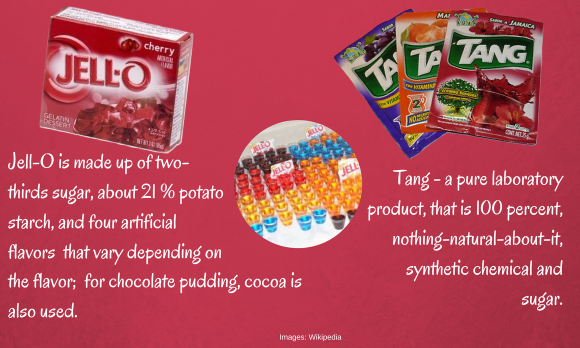
Tang a pure laboratory product
On page 57, Moss calls Tang a pure laboratory product, that is “100 percent, nothing-natural-about-it, synthetic chemical and sugar.” Sugar and starches ... In the 1970s, Tang came on the market in China. Taste tests there showed that the farther south you go, the sweeter the people like their Tang. Brim, another powdered drink, was introduced onto the market as “breakfast in a glass” in 1961 (until 1995).
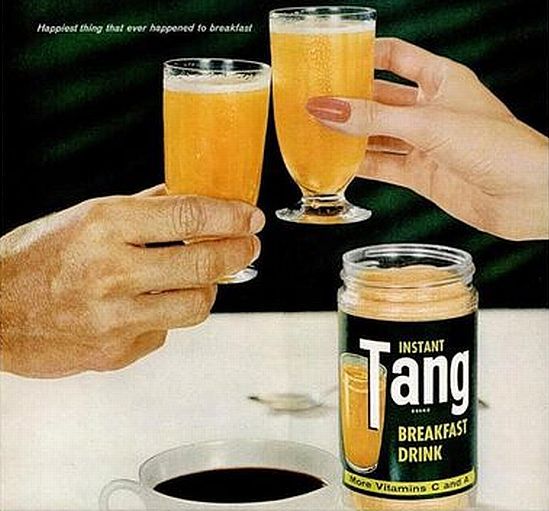 | On page 49, Moss states that Clausi also invented Tang, another one of the big hits at the time (1957, on the market starting in 1959). However, Wikipedia lists William A. Mitchell (1911–2004) as the inventor. |
Mitchell is also listed as the key inventor for Jell-O, Pop Rocks, Cool Whip, and other similar products (a total of 70 patents). He worked at General Foods from 1941 to 1976.
Brim was, according to Wikipedia, a caffeine-free coffee, which thanks to its sweetness enjoyed immediate success. In 1964, the breakfast hit from Post, toaster pastries, named Toast’em Pop-ups came on the market.
Moss explains how the companies fought for market shares. Betty Dickson from the American Home Economics Association (AHEA) was the role model for the army of school teachers who fought against convenience foods. Dickson gave traditional cooking classes on the radio and TV. Michael Moss describes the fight of the traditional against the modern and how the industry used the fictional character Betty Crocker (similar to Betty Bossi in Switzerland) to thwart the true Betty and get the upper hand. After this, the industry infiltrated the organization and turned it in an entirely different direction.
How the companies fought for market shares
Postum, established in 1895, began to make acquisitions, most notable of which was General Foods in 1929.
On page 53, we read that General Foods, with the help of Goldman Sachs, purchased the companies Jell-O, Kool-Aid, and Log Cabin Syrup along with parts of Oscar Mayer, Entenmann, Hellmann, Maxwell House (coffee), Birdseye (frozen food), Minute Tapioca, and others.
In 1985, General Foods was purchased by Philip Morris; at this point, General Foods had annual sales of $9 billion, a research budget of $113 million, and 56'000 employees. But it would only continue to grow.
Betty Dickson from the American Home Economics Association (AHEA) was the role model for the army of school teachers who fought against convenience foods. Dickson gave traditional cooking classes on the radio and on TV. The AHEA was founded in 1908 and reached its peak in the 1960s with just over 50'000 members. In 2012, the association only had about 10 % of the numbers it had once had.
Michael Moss describes the fight of the traditional against the modern and how the industry used the fictional character Betty Crocker (similar to Betty Bossi in Switzerland) to thwart the true Betty and get the upper hand. After this, the industry infiltrated the organization and turned it in an entirely different direction. In 1994, the AHEA changed its name to the American Association of Family and Consumer Sciences (AAFCS).

Note: On Wikipedia, you can find information about the two fictional characters, but unfortunately nothing about Betty Dickson, who was a real person and much more important.
The manager of the advertising department at Washburn Crosby (formerly Washburn A Mill Complex), which later became General Mills, was the one who invented Betty Crocker. The company successfully made the idea of convenience foods popular.
The food industry developed products that promised the largest sales and profits. It focused primarily on things that children crave as children would soon become the new consumers (p. 63).
2.4. Is it Cereal or Candy? (p. 68)
Starting on page 68, Moss explains how the change from a meat-based breakfast to a sweet breakfast took place. John Harvey Kellogg (1852–1943) wanted to find a breakfast that wouldn't cause indigestion, also known as dyspepsia, or heartburn. In the late 1880s, many Americans suffered from this condition of impaired digestion. Their breakfast consisted of sausage, beefsteaks, bacon, eggs, fried ham, and oatmeal. When Kellogg was a medical student, he saw the negative effects of this type of breakfast.
John Harvey Kellogg, Graham bread and Battle Creek Sanatorium

Note: According to Wikipedia, he took over an existing health institute in 1876, and as he was a physician, was able to transform it into a sanatorium. He offered a diet based on whole grain products such as bread created by Sylvester Graham, which was called Graham bread.
Kellogg detested both salt and sugar as he recognized that both could cause health problems. The diet offered at Battle Creek Sanatorium contained neither of these ingredients.

Kellogg also made sure that his patients got enough exercise. He achieved great success, which can be seen from the fact that his sanatorium had about 700 beds in the year 1900.

Note: He achieved this by offering only vegetarian foods, that is vegetarian cuisine, which wasn’t even a vegan or raw food diet.
Starting in 1894, he developed the cereal Corn Flakes together with his brother Will Keith Kellogg. And then in 1897, Dr. Kellogg began to serve this for breakfast at his sanatorium. The unsweetened corn flakes replaced a type of popcorn made from wheat.
In 1906, Dr. Kellogg was gone for a longer period of time, in which his brother Will Keith began to add sugar to the corn flakes. This change to the original recipe caused a falling out between the brothers. Will Keith established his own company, which became the Kellogg Company (p. 70).
The book "Cornflake Crusade"
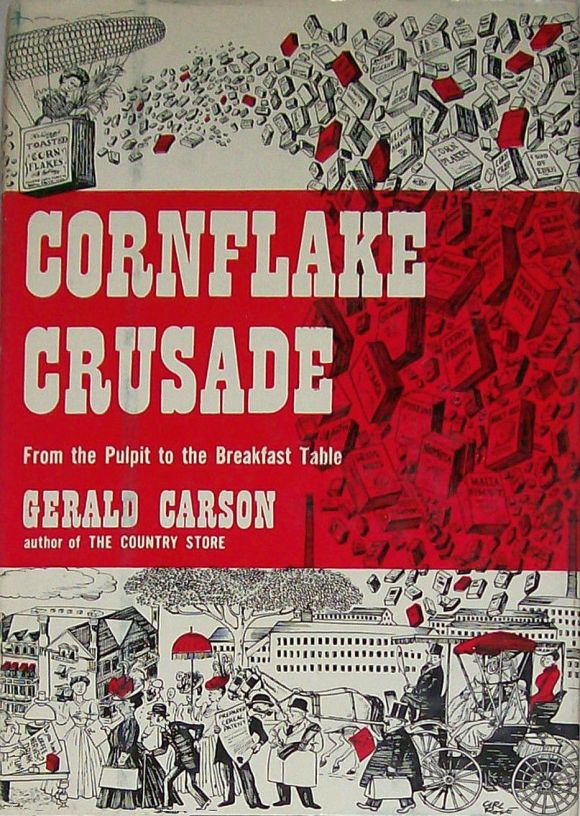
| The book Cornflake Crusade by Gerald Carson looks at the power struggle around the “sweet breakfast.” Howard M. List, an advertising manager at Kellogg, quotes Carson (as per Wikipedia): "Via television, we can sell our children products even before they have learned to talk. They know their TV heroes before they can talk in complete sentences. Children used to eat what their mothers bought, but today children tell their mothers what they should buy." |
It is telling that there is still (September 2013) no information about the “real” Betty Dickson on Wikipedia, but that both of the fictional Bettys are discussed.

Note: In a blog, a woman named Mary writes, Dr. Kellogg and Reverend Graham can eat worms. But it's the chocolate and marshmallows that make it possible for me to eat the cracker.
One of the guests at Battle Creek Sanitarium, Charles William Post “C.W.” Post (1854–1914) started a rival health spa in 1892. Starting in 1897, he had his guests served Postum, a coffee substitute, and also Grape-Nuts. Grape-Nuts is a mixture of wheat and barley that is mixed with sugar and then baked. Post manufactured this cereal at his company Postum Cereal Co., which he established in 1895. His sweet breakfast cereal was the core business of his company.
Brains are built by Grape-Nuts
Post practically invented marketing; by 1897, he was spending a million dollars a year on advertising. And then he earned back the same amount in dollars (net). In contrast, Dr. Kellogg had to later give up his sanatorium as he had three million dollars in debt. Post had many slogans including “Brains are built by Grape-Nuts.”
The small town of Battle Creek, established in 1831, was soon home to 108 brands of cereal. But only General Mills became strong enough to join the two big competitors Post and Kellogg. In 1949, Post (now part of General Foods) was the first of the three to add a candy coating to his cereal; he named it Sugar Crisp, a name that was later changed to Golden Crisp (p. 71).
Moss includes a footnote on page 71 with information about an article titled The Great American Frauds that appeared in Collier's Weekly in 2011. The article suggests that Post was using fictional doctors to confirm that Grape-Nuts could cure appendicitis.
In response, Post spent $150'000 on advertising to make the public believe that the editors were claiming this because they were upset that they weren't receiving any of Post's advertising business. The magazine then sued Post for libel and won.
| Today, the Post empire is called Post Holdings and is part of General Foods, which at least used to be the largest food company worldwide. In 1985, the tobacco company Philip Morris (PM) purchased General Foods. The first step away from tobacco for PM was the acquisition of Miller Brewing Company on June 12, 1969, followed by W.R. Grace and other “smaller” food companies. | ||
| In December 1988, PM also purchased Kraft, Inc. Since 2003, the focus at PM has been on acquiring brands and no longer on promoting the company's own name. Here is a link with information about the Altria Group, Inc. | ||
By 1970, the Big Three, Kellogg, Post, and General Mills controlled about 85 % of the cereal market (p. 72). Annual sales grew rapidly, from $660 million in 1970 to $4.4 billion in the mid-1980s.
In 1976, the Federal Trade Commission (FTC) brought a complaint against the Big Three because they weren't leaving any shelf space free for other companies and had therefore pushed up the cereal prices. In this way, the companies had earned $1.2 billion additional profit by overcharging customers since 1958.
The industry's incredibly strong defense made sure that nothing ever came of this antitrust action. The commission dropped the case in 1982.
A third of the products had a sugar content of 50 % to 70 % by weight
The industry lobbied hard and had many allies in the federal government, and the Food and Drug Administration (FDA), the food control authority, often turned a blind eye.
This went on until pressure from consumers increased and Ira Shannon worked to get things changed. Shannon, a dentist, demanded in 1975 that the food manufacturers reduce the sugar content in their products. His main argument was that the sugar was causing exploding rates of tooth decay in young patients (p. 73).
According to Moss, Ira Shannon tested 78 brands of cereal in his laboratory.
Ira Shannon brought several key figures to action. These included Jean Mayer, who worked on the issue of obesity, Michael Pertschuk, a public attorney, and Ralph Nader, but this group fought with achieving hardly any success (p. 77).
The only thing the industry did was drop the word “sugar” from the products that had been under attack; the content remained the same (p. 82).
In 1990, the retailers Safeway (2008: $44 billion in annual sales) and Kroger started their own product lines. In 2010, Kroger reached annual sales of $82 billion, had about 3'500 stores—2'500 of which were supermarkets—and 334'000 employees. In 2010, Kroger also had about the same number of employees and annual sales as Nestlé, the largest food manufacturer. Kroger sold its products at up to a third below the price of the brand-name products. The food industry's sales declined sharply. The only possible response was to lower their prices.
The industry also introduced new sweet temptations such as Rice Krispies, CinnaMon, and Bad Apple (43 % sugar content). And then Frosted Minis were sold as brain food in an attempt to win parents over.
These claims were not true, and the study had purposely designed in such a way that it would achieve these results (p. 91). Kellogg was the only of the food manufacturers spending a billion dollars annually on advertising.
2.5. I Want to See a Lot of Body Bags (p. 95)
Michael Moss points out that it is primarily the calories in sugary drinks that are the problem. Researchers have determined that people don't hardly experience a feeling of fullness after they have had calorie-rich drinks. The drinks apparently flow too quickly past the taste buds.
If you look at the sales statistics for Coca-Cola and PepsiCo and compare these with statistics on obesity, you will see what has happened. And many additional drinks have also been introduced onto the market.
The methods that Coca-Cola uses
Readers learn about the methods that Coca-Cola uses—and how and why Jeffrey T. Dunn (1981–2001 or 2002 at Coca-Cola) finally left the company.
Dunn explains this to MOSS in personal interviews. Before Dunn left the company, he was the CEO for Coca-Cola America. For many decades, the Coca-Cola brand held the number one spot on the list of the most well-known brands. This required superior marketing at the highest level.
| The severance agreement offered to Charles S. Frenette when he left Coca-Cola can be found here. It is quite telling. He left the company around the same time as Dunn. Agreements such as this are usually made when a company dismisses an employee or has them take early retirement. I have a 2-liter plastic bottle of Coca-Cola in front of me. The label says the following: 42 calories and 10.6 g sugar per 100 mL; a serving (250 mL) is only 5 % of the daily calories, but 29 % of the recommended daily allowance of sugar. If a person were to drink 2 L a day, which would be the entire bottle, that would be 40 % of the calories they need for the day just from drinking, but most astounding, it would be 232 % of the recommended daily allowance of sugar! |
In 2010, Coca-Cola reached annual sales of $35 billion—with more than 200 drink brands.
Not only the size of the packaging was effective, but also the market power that the company zealously defended.
Although Roberto Goizueta (CEO as of 1980; 1931–1997, died of cancer), together with Donald Keough (COO at the time, 1926–2015), introduced the very successful Diet Coke in 1982, the company lost market shares to PepsiCo.
The market share of 60 % in 1945 had decreased to 24 % by 1983.
Keough left the company in April 1993 and began to work for the investment banker Allen & Company. Coca-Cola voted him onto the board of directors in February 2004. He also served on numerous other boards, including McDonald’s Corporation, the world's largest chain of fast food restaurants, and H. J. Heinz Company.
Here is an impressive list of fast food restaurant chains found globally and in specific countries.
The fact that Donald Keough was on the board for The Washington Post Company, later Graham Holdings Company, shows just how closely the industry is connected to the opinion makers. In 2010, the company achieved more than $5 billion in annual sales.
Quite early, at least until after the war, Coca-Cola focused its attention on the areas where children develop their likes and dislikes—that they usually keep for life. I, myself, clearly remember my class field trip to the Coca-Cola bottling factory in Basel.
But the company has not always had successes. In 1985, it tried to replace the real vanilla in Coca-Cola with artificial vanillin.
The name stayed the same, but with the advertising slogan “The New Taste of Coca-Cola,” the soda was unofficially known as New Coke. The drink was such a flop that the company reintroduced the original formula and rebranded it as Coca-Cola Classic.
An overwhelming 8'000 complaint letters per day showed just how severe the protest was. Coca-Cola Classic, the company's saving grace, was later renamed as just Coca-Cola (II). After this, the market shares were once again intact.
See also this list of Coca-Cola brands and the link on The Coca-Cola Company.
It wasn't until 1990 that Charlie Frenette, the chief marketing officer for the entire group, determined with the help of Givaudan why Coca-Cola is so addictive. Moss explained the considerations and points out that Coca-Cola changed from sugar to high fructose corn syrup in 1980. The advertising budget alone was $181 million in 1984.
Between the years 1980 to 1997, Coca-Cola's sales worldwide increased from $4 to $18 billion (p. 109). By 1997, Americans were drinking an average of 200 liters (54 gallons) of soda a year. Consumers normally find sodas in the prime selling positions in supermarkets and corner stores (c-stores and convenience stores). The latter are often located near schools or students pass by these on the way home from school, meaning that Coca-Cola is really the cash cow for the owners (p. 114ff).
Soda

| The term soda doesn't mean soda water, at least in the United States, but instead refers to all artificially sweetened drinks like Coca-Cola. Alcopops contain both alcohol and soda and therefore count as soda. On the Wikipedia page, you can read how various countries were able to discourage this drink that contains 5 to 6% alcohol (see also the different types of drinks). Today, we also have functional beverages, for example, sports drinks, isotonic drinks, and energy drinks that interestingly the Deutsche Gesellschaft für Ernährung (The German nutrition society, DGE) has a critical to negative view of. Even if this position is reasonable, other positions that the DGE has taken are hard to understand. It is easy to see that lobbying done by interested parties plays a role here. To conclude, I have linked the Wikipedia pages to these beverages as it is important to know about them since they can contribute significantly to poor health. |
2.6. A Burst of Fruity Aroma (p. 121)
In this chapter, which reads almost like a novel, Moss describes an important meeting in February 1990 where the 12 most important heads of Philip Morris, the world's largest tobacco company, came together.
Kool-Aid from General Foods and fructose
The CEO at the time was Hamish Maxwell, but his two predecessors Joseph Cullman III and George Weissman were also present as advisors, as was the future CEO Geoffrey Bible.
The meeting was about the problem child Kool-Aid from General Foods. This product was in danger of being pushed out by Squeezits from General Mills, an archrival.
The discussion revolved around the target groups of mothers and children and therefore a new formula was decided upon that would contain one-half of a spoon of fruit juice (about 5 %). This way, the company could focus their marketing on the natural fruit juice in Kool-Aid, without having to mention fructose.
Fouad Saleeb developed the formulas so that the fructose, instead of sugar, would stay stable for a year. This lowered production costs significantly and also allowed the product to be marketed as a drink with “25 % less sugar as compared to Coke.” However, fructose is problematic as it causes LDL cholesterol levels to increase.
The WHO had wanted to recommend that only 10 % of a person's daily caloric intake should come from sugar, but it withdrew its proposal as a result of pressure from the food industry.
In 1991 and after the success with Kool-Aid, Philip Morris purchased Capri Sun for $155 million and then soon had annual sales that amounted to $230 million. Capri Sun is a drink that is made up of fructose concentrate and fruit concentrate.
On page 134, Moss lists off the differences between concentrates and real juices - at its extreme, a concentrate can be a purely chemical formula that is known in the industry as stripped juice.
Nutritional rating systems
See also information on the Nutritional rating systems page about Adam Drewnowski (Naturally Nutrient Rich, NNR), David J. Jenkins (Glycemic Index (GI), developed in 1981), and others; the sections include many additional links.
Today the GI is “out,” and we should now instead monitor the glycemic load (GL) of the foods we eat.
Carrots and baguettes both have a GI of 70. However, eating about 100 g of a baguette causes the same blood glucose response as eating about 700 g of cooked carrots. We can eat 100 g of a baguette quickly, but it would take us longer to eat 700 g of carrots.
On Wikipedia, you can read about the various industrial processes used to produce juice and orange juice. In the Wikipedia entry on juice (2013), we read why fresh fruit juices have positive health benefits even though, for example, a typical grape juice (must) contains 50 % more sugar than Coca-Cola.
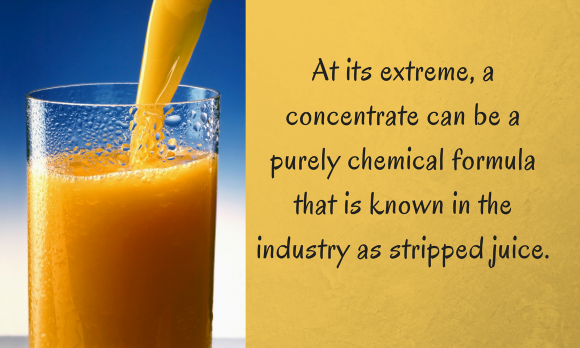
FAT
There is more than sweet, which Aristotele (see details below) named the first taste. We also have bitter, salty, harsh, astringent, and acid, which he saw as a counterbalance to sweet. Even back then, Aristotle knew that the “fat or oily” taste is just as important as the sweet one.
Today, we also recognize umami as one of the basic tastes. This taste can be described as meaty and savory. See also sodium glutamate, also known as monosodium glutamate (E number E621), which is used as a flavor enhancer. This is often mixed with some guanosine monophosphate (E626) or inosinic acid (E630–E633) in order to achieve the best effect.
2.7. That Gooey, Sticky Mouthfeel (p. 145)
Fat does at least two things for convenience foods: the industry uses it to achieve more volume and a firmer texture, for example, with baked goods.
Based on studies conducted by industry and research, Michael Moss discusses things that the industry has discovered in connection with fat. The newest studies use very expensive functional magnetic resonance imaging (fMRI).
Things that the industry has discovered in connection with fat
On page 147ff, Moss explains several practical reasons why the food industry often adds fat to products. In addition, the industry doesn't want sugar to blast away the mouthfeel, but they want this mouthfeel to last. This can be achieved by adding fat and salt. But researchers have not actually yet been able to identify receptors in the taste buds for fat or oil.
In 2003, Edmund Rolls, from the University of Oxford in England, published such a study funded by Unilever. This study served to look at the effects of sugar and fat in the brain.
Moss describes the study and the researchers' astonishment. They were very surprised that the brain's reward center reacted with intense feelings of pleasure just as intensely to fat as it did to sugar even though specific receptors on the tongue appear to be lacking.
Fat turns listless chips into crunchy marvels, parched breads into silky loaves, and drab lunchmeat into savory delicatessen (p. 146).
Unilever invested $30 million in these studies. In addition, the company gave Francis McGlone his own team and the task of using fMRI to analyze the effects on the subjects directly in the brain. The team was able to use this information to determine the most effective formulas.
After a project that started in 2005, Unilever (total sales in 2012: €51.3 billion), the largest ice cream manufacturer worldwide, was thrilled to finally be able to announce that “Ice Cream Makes You Happy—It's Official!” And the journalists spread the word with enthusiasm (p. 151).
In 2008, the scientists Massimiliano Zampini and Charles Spence, who conducted the hearing tests, received an “anti-Nobel Prize,” an Ig Nobel Prize for their findings that food tastes better when the chewing noise is louder. The intent of the prize is to honor achievements that first make people laugh, and then make them think.
The presentation of prizes and list of Ig Nobel Prize Winners began in 1991 at MIT. Today, the awards ceremony takes place at Harvard University. The hearing test study was published in the Journal of Sensory Studies, Vol. 19, Issue 5, October 2004, pp. 347–363.
At General Foods, Alina Szczesniak researched fat until 1986 in order to develop products similar to Jell-O. In this time, she developed a long list of terms to describe fat and oil, such as smooth, firm, bouncy, wiggly, disappears, slippery, gummy, melts, moist, wet, and warm.
 | At Nestlé, Johannes Le Coutre used electroencephalography (EEG) for his studies. This is a way to record electrical activity in order to pinpoint certain phenomena. The result of his work was a 609-page book published in 2010. See his book "Fat Detection: Taste, Texture, and Post Ingestive Effects". |
The popular opinion about fat has been negative for more than a hundred years. Consumers view fat as absolutely detrimental to their health. In the 1960s, milk was seen as being too fatty, and the dairy industry then moved toward low-fat milk.
It was ultimately shown that when substances such as sugar and fat are combined—as long as this is done well—they have the potential to be highly addictive. The sensation takes place in the same place as with heroin. Chocolate cookies like Tim Tams are an example of this (p. 156).
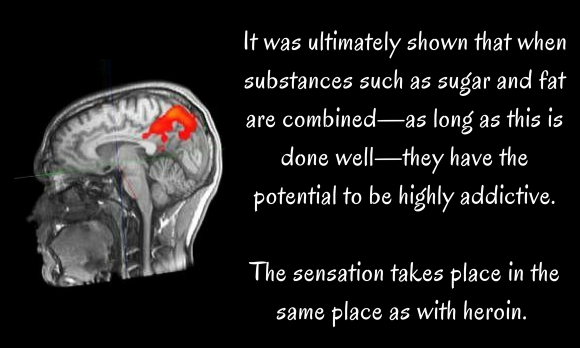
Adam Drewnowski, a professor for epidemiology, began his research on fat in 1982. He was familiar with the bliss point for sugar and also the work done by Szczesniak at General Foods on the texture of fat. He searched in vain for the bliss point, or break point, for fat and then determined that there was no such thing for fat. He discovered that the brain doesn't give a signal to stop eating fat. He found that the test subjects liked foods even better when sugar was added. Fat and sugar together increased people's cravings dramatically.
The brain doesn't give a signal to stop eating fat
The test subjects were able to quantify the sugar content in foods quite well, but not the fat content of the invisible fat. When the testers added both fat and sugar to a food, the test subjects thought that the testers had instead reduced the sugar.
Drewnowski published his study Invisible Fats in 1990. His conclusion was that fat is trickier than sugar. In most sweet candy bars, 60 to 80 % of the calories come from fat, not from sugar. But only people who carefully study nutrition labels would know this.
In 2005, Adam Drewnowski published his study on the naturally nutrient rich score (NNR) of foods in The American Journal of Clinical Nutrition.
Adam Drewnowski held that we often only measure healthy foods based on the absence of substances that have fallen into disrespect. Foods were being introduced that were increasingly richer in energy but poorer in nutrients. He based his score on the mean percentage daily values (DVs) for 14 nutrients and wanted to have the descriptions on product labels changed.
2.8. Liquid Gold (p. 160)
Dean Southworth worked at Kraft for 38 years, where he invented many products, the most notable of which was Cheez Whiz. Mondelēz International called a newer version of this Easy Cheese. Note: The term cheese analogs (cheese alternatives) is generally used for these processed cheeses.
After a year and a half of development, the product came on the market in July 1953 as one of the first convenience foods. This cheese alternative was a great spreadable cheese to use on salty and buttery crackers. People enjoyed eating crackers with spreadable cheese on top while watching TV in the evenings.
In 2001, after Southworth had retired, he was eating Cheez Whiz one day and knew immediately that Kraft had changed something. The list of 27 ingredients no longer included cheese. Before this, Kraft had always included some real cheese as a way to give the product legitimacy.
The first German processed cheese
The wholesale company Gebrüder Wiedemann (Wiedemann brothers), which was founded in 1892, introduced the first German processed cheese onto the market in 1922 under the brand Adler. At about the same time, the French launched their own version called “La vache qui rit.” In 1925, a company in Austria also started producing processed cheese under the brand Alma. Another type of premelted cheese is called Cancoillette, a sour curd cheese made from quark.
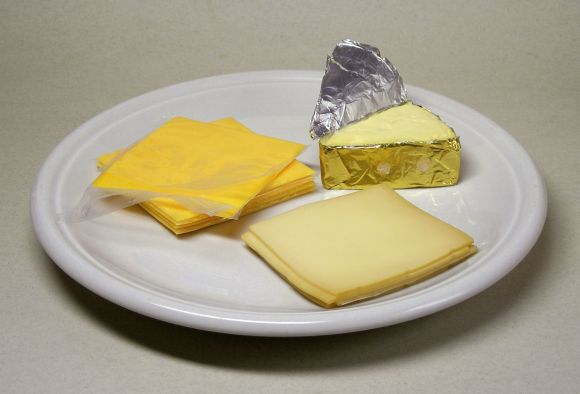
Starting in 1911, Walter Gerber produced processed cheese at Gerberkäse AG in Thun (Switzerland) under the brand GALA.
It wasn’t until 11 years later, that a second company followed suit ...
Since we love cheese so much, it is now found in pizzas, crackers, and convenience foods—and is even an ingredient in many breakfast products.
Compared to the early 1970s, Americans now eat triple the amount of cheese and pseudo-cheese. This means that Americans are now exceeding the maximum recommended allowance of fat by more than 50 %. Each year, Kraft alone sells $7 billion of cheese and cheese alternatives.
A way to prevent cheese spoilage
James Lewis Kraft delivered cheese to grocers using a horse-drawn cart. His main problem was that the cheese was constantly spoiling.
Starting in 1912, he searched for a way to prevent spoilage as this can, of course, lead to foodborne illnesses (food poisoning). After three years of experimenting, he found the solution. When he stirred continually while the cheese heated, the fat didn't separate from the protein. Using this method, he was able to sterilize the cheese and fill it into cans.
It didn't take long for word to spread about Kraft Cheese, which would keep well and tasted great.
Thanks to this success, Kraft was able to hire his four brothers. The company was hardly able to keep up with the demand, especially since the army was buying the cheese to use in field rations.
By 1923, Kraft had become the largest cheese manufacturer in the world. In 1927, Kraft acquired Velveeta, another processed cheese, by purchasing the cheese company founded by Caleb Hommel in 1908.
Speed up the production process and make it cheaper
Another patent was filed for the addition of sodium phosphate. Norman Kraft, one of the brothers, obtained a patent in 1940 for his process of cutting cheese into thin slices.
In the 1970s, enzymes were used to speed up the production process and make it cheaper. After 10 years of experimentation, Kraft invented a single continuous process that allowed normal cheese that before had required 18 months to ripen to be produced in just a few days. As a result, Kraft was able to manufacture cheese directly without having to put it in storage. Ultrafiltration was the magic formula here.
The Dairy and Tobacco Adjustment Act
At this time, consumers had already recognized that milk was high in fat. It took the cooperation of the dairy industry, Kraft, and the government to solve this problem.
Typical dairies, many of which were in California, had herds of 500 to 2'000 cows that were kept in gigantic stalls with artificial light. The cows were genetically bred through artificial insemination in order to increase their milk production even more.
Since 1930, there has been a law in place requiring the government to subsidize milk and buy all of the surplus milk. In 1981, this cost the United States $4 billion. Just the costs of storing the milk increased to $1 million per day.
The government tried to stop this and invested about a billion dollars to send 339'000 milk cows to early slaughter. But then, these well-paid farmers simply bought new cows ...
In 1983, lawmakers decided that it wasn't dairy cows that were the problem but that it was the consumers.
They developed a law called the Dairy and Tobacco Adjustment Act as they both wanted to provide the tobacco industry with assistance and reduce the number of smokers. They therefore gave the dairy industry money that was to be spent on marketing cheese. They did this although they knew that the saturated fatty acids in cheese increased the risk of heart disease.
Soon after Kraft was acquired by the tobacco giant Philip Morris (PM), it introduced a line of flavored cheese. After extensive consumer testing, the perfect formula was developed and consumers loved this cheese alternative even more. This was also because of the increased fat content, which made the cheese even more attractive. After this, Macaroni & Cheese was introduced, which the industry called “the blue box.” It sold for only $1.19 and was a big hit—it had annual sales of $300 million.
Cheese and diabetes
The more cheese that a pizza had, the more desired it was. By 2009, the food industry was selling $4 billion in frozen pizzas each year.
Kraft alone brought in $1.6 billion from its frozen pizzas. But Philip Morris, which had purchased Kraft, wanted to see even better numbers.
To this end, PM got Paula Deen, who was well known for her TV cooking show. And at the same time, the company used Facebook, Twitter, and Google advertising to reach its goals.
In January 2012, Paula Deen announced that she had had diabetes for three years. After this, she publicly represented Novo Nordisk, the world's largest manufacturer of the peptide hormone "I" and other diabetes drugs.
Note: Cooking the cheese-heavy menus that Paula Deen promoted so heavily is the surest way to get diabetes.
| Opened aorta showing arteriosclerotic changes: arteriosclerosis caused by diabetes. |
2.9. Lunchtime Is All Yours (p. 182)
Moss traces the history of Oscar Mayer, which as of 1883 was considered the king of quality meat. As described in Upton Sinclair's book "The Jungle", the industry manufactured products very negligently when it came to purity. Since red meat, in particular, came under attack because of its large proportion of saturated fats, sales fell by 10 % between 1980 and 1990. But sales of poultry increased by 50 %.
Oscar Mayer altered its Beef Bologna, a type of Bologna sausage or Brühwurst (cooked sausage) but also a convenience food, in order to improve the numbers. But only new products were able to help prevent a loss of sales.
“Chilled prepared foods” and a promotion called “Talent Search”
Moss tells this story that started in 1985 in detail. He describes the various market tests conducted to find the best marketing mix—until the convenient Lunchables were ready to go on the market in 1988.
Lunchables fall in the category of “chilled prepared foods.” They are on-the-go meals that consumers can eat while they are walking or driving.
Bob Drane, who was in charge of the product at the time, told Moss the Lunchables story. Go to the above link to read more about Lunchables.
In 1995, Oscar Mayer, with the help of the tobacco industry, started a promotion called “Talent Search” in which they sent out 10 Wienermobiles to 50 states.
This allowed the company to hold 700 events, which nearly 45'000 children took part in. The result was a national increase of sales by more than 10 %, In the four years before this, 90 % of the products had a different formula.
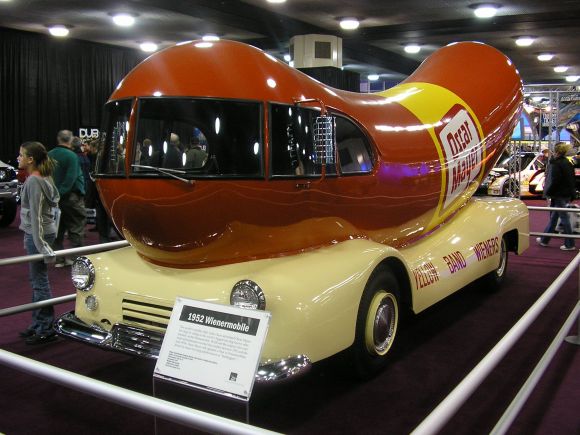
Wikipedia has information about the special vehicles that Oscar Mayer used starting in 1936. These were in the shape of a hotdog and were also called Wienermobiles.
The company was founded by Oscar Ferdinand Mayer (1859–1955) (Wikipedia entry: Sept. 2013).

In 1981, the stockholders sold Oscar Mayer to General Foods. Four years later, it was acquired by the tobacco company Philip Morris, which then merged it with Kraft Inc. in 1989.
The hot dog entries on Wikipedia are very different for each of the languages.
With the acquisition of General Foods ($5.7 billion) and Kraft ($12.9 billion), Philip Morris (PM) achieved $51.2 billion in sales worldwide in 1990 with 157 thousand employees. Half of its revenue came from tobacco and half from food, but 70 % of the profits still came from tobacco. In spite of antismoking measures, customers remained loyal to the brand. Geoffrey C. Bible (1937– ), PM's “ambassador” to Kraft and later CEO (1994–2002) for PM, told Michael Moss many interesting things about the company culture.
We should know that PM only had a market share of 9 % in 1954, but that this had grown to 45 % by 1989. And they accomplished this in a very competitive market.
When, in 1964, the public became aware of the harmful effects of cigarettes, the tobacco industry began to reduce the adverse effects by introducing filter cigarettes. The food industry subsidiaries of PM understood how to extract caffeine from coffee. And PM was able to use this technology to pull the nicotine out of tobacco. However, smokers didn't like these new cigarettes and stuck to their old habits. Later, there would also be much negative publicity about nicotine.
The book continues with the story of how more sugar was added to Lunchables in 1991. This made it possible for Lunchables to regain its popularity, in particular, when it came to children. Kraft initially tried to add carrots, apple slices, and other fresh products to these ready-to-eat lunches, but they soon realized that this wouldn't work because of the constraints of the long storage period that was required (transport and shelf life).
By the mid-1990s, pizza had become one of the most popular foods in the United States.
The story of the many convenience foods out there
60 thousand pizza restaurants were making $26 billion in pizza each year. The annual sales of $6 billion in 1970 had increased to about $93 billion in 1995 as a result of franchises such as Pizza Hut, Domino's, and Jack in the Box. These accounted for about a third of the total restaurant sales in the US. The food industry also sold another $1.7 billion in frozen pizzas.
Starting on page 204, Moss tells the story of the many convenience foods out there. In 1999, Bob Eckbert, the CEO of Kraft, said that Lunchables make it possible for kids to choose what they want to eat, anytime and anywhere.
This targeting of kids made it possible for cold pizza to have a chance.
Taco Bell was able to introduce Mexican food such as cheesy Beef Taco Wraps as a new trendy food, and McDonald's brought the Happy Meal on the market. Ultimately, all of these elements were brought to Lunchables.
A total of 60 different varieties of Lunchables were created, and these often replaced a sensible breakfast and/or dinner.
In 2007, Kraft even launched Lunchables Jr. onto the market, which was a version aimed at three- to five-year-olds.
Result: by 2009, almost 25 % of adults had diabetes. In comparison, the 1990s showed that 10 % of children ages ten and above had joints that had stiffened and thicker arteries, such as those found in 45-year-olds.
The worst-rated prepackaged meals contained 57 grams of sugar, 1.6 grams of salt, and an additional 9 grams of saturated fat.
Eating disorders
| | Unhealthy eating behaviors, such as an increased appetite and food cravings, can be caused by genetic or psychogenetic disorders (psychogenesis). These are called eating disorders. A particularly rare but serious genetic disorder is, for example, Prader–Willi syndrome (PWS). Children who are obese and have typical symptoms are tested for PWS. Depending on the extent of damage to chromosome 15, the disorder may be classified as Pradar–Labhart–Willi–Fanconi syndrome (not Labhard), Urban syndrome, or Urban–Rogers–Meyer syndrome. This also includes diencephalic dysfunction (interbrain or diencephalon). On average, Pradar–Willi syndrome only occurs in one of 10'000 to 15'000 children. See also nutrition psychology. |
2.10. The Message the Government Conveys (p. 212)
This chapter describes the history of the United States Department of Agriculture (USDA) with its 111'000 employees (2004, later 117'000). This agency is supposed to serve the about 312 million people in the United States, but it has a conflict of interests between the people and the $1 trillion food industry.
Instead of protecting people from diseases, the USDA has helped to persuade consumers to consume more.
United States Department of Agriculture (USDA)
President Abraham Lincoln established this institution in 1862, and in 1889, it was officially named the Department of Agriculture.
Moss compares the miserable status of the only division that works solely to protect people’s nutritional health. This division for health receives only $6.5 million per year, which is deplorable if you consider that the Department of Agriculture has an overall outlay of $146 billion annually. That means that they receive only 0.0045 % of the budget (p. 214).
See my comments on this subject below (image).
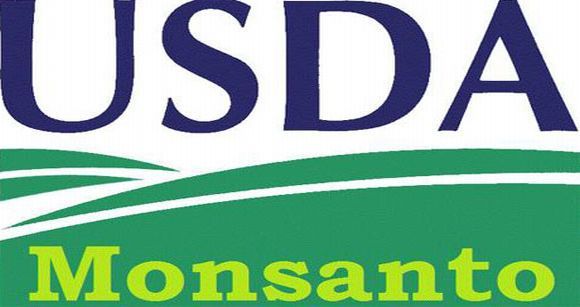 | The USDA's FY 2014 Budget Summary shows a budget of $116 billion (2009), $130 billion (2010), $143 billion (2011), $152 billion (2012), $153 billion (2013), and $146 billion (2014). |
Image: Spence Cooper reports at blog.friendseat.com on March 5, 2012: Under forthcoming new USDA rule changes, Monsanto and other seed companies will get speedier regulatory reviews of their genetically modified crops.
Wikipedia (German entry) states that the budget for 2006 was only $94.6 million, which is a thousand times less. This number isn't included in the English Wikipedia entry. A total of 117'000 employees with costs of $100'000 per year would come to $11.7 billion. It would be interesting to see an analysis of the major costs.
The USDA report from 2010 estimates that 32 million Americans take tablets to lower their cholesterol levels. That is a little over 10 % of the population.
They estimated that about 24 million Americans were affected and that another 79 million had prediabetes. And even worse, an increasing number of children were getting type 2 diabetes: 3'600 new cases per year. Diabetes mellitus is an umbrella term; it is commonly known as diabetes.
"People should eat more cheese instead of less"
The data showed that children up to age three got 12 % of their calories from saturated fat and that older children got 11.5 % and adults 11 %. The USDA recommended no more than 7 % and with this move, they reduced the previous limit of 10 % (p. 215).
Grain-based desserts such as chocolate cakes and cookies, which contain a large amount of oil, contribute 6 % of the fat in the average diet.
The small USDA health division found an ally in Walter Willett from Harvard's School of Public Health as he had drawn the same conclusions.
And then the “big USDA” published in their 2010 guide that people should eat more cheese instead of less (p. 215)
Luckily for consumers, there is also the Food and Drug Administration (FDA), which is independent of the USDA, and in 1990 the FDA was able to require companies to clearly label the ingredients and nutritional information on their products. Then at least those consumers who are trying to live mindfully and ask questions will know what the main ingredients in a product are.
Meat: the more fat it has, the cheaper it is
One of the main problems with meat is that the more fat it has, the cheaper it is. And the Department of Agriculture allowed the industry to label meat with the word “lean,” for example, “70 % lean and 30 % fat.”
This allowed the companies to advertise meat in a positive light. Even the fattiest hamburger is labeled this way.
Seven of the thirteen members on the decision-making panel were nominated by the Grocery Manufacturer's Association, a trade association of the food industry. Others had previously worked in the industry, for example, Roger A. Clemens, who had been a product developer at Nestlé for 21 years. We need experts they would say, as if there weren't any independent and unbiased experts available (p. 219–220).
The industry undermines and discredits this type of researcher. And it can have a strong influence on the media. I think that when this happens the media is like a puppet that doesn't know that it is a puppet. It is most effective for the industry when they can influence nutrition specialists. Without even knowing it, these individuals help the most.
Moss describes how the industry engages in lobbying and uses spurious arguments, how they bring these agreements to the public, and what takes place in Congress.
After this, he points out some of the tricks that the dairy and meat industry use and looks at the results of alarmists that ultimately disappear when they come up against so much power and influence.
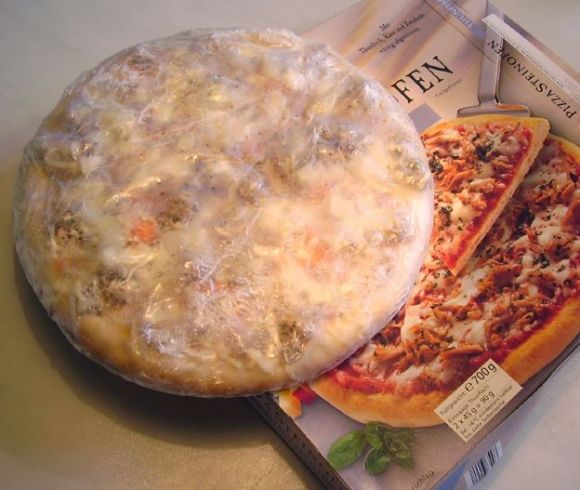
On page 230, he discusses convincing scientific studies that show how eating meat increases the risk of colorectal cancer significantly: Every 1.7 ounces of processed meats consumed per day increased the risk of colorectal cancer by 21 %.
2.11. No Sugar, No Fat, No Sales (p. 236)
In chapter 11, “No Sugar, No Fat, No Sales,” Michael Moss uses numerous examples to show how the tobacco and food companies take action when they come under criticism or when they discover new opportunities to design and advertise products so that they will generate increased revenue (pp. 236–254).
He also includes information taken from the industry's secret papers. We learn what happens with employees who try to address and solve the problems, for example, Michael Mudd and Betsy Holden (co-CEO of Kraft).
Oreos - the “mother of all cookies”
In 2000, Philip Morris purchased Nabisco (National Biscuit Company) from the second-largest tobacco company R.J. Reynolds Tobacco Company (RJR) for $18.9 billion and then merged it with Kraft.
Kraft was supposed to solve the problem of trans fats in the popular Oreo cookies. Oreos are called the “mother of all cookies.” After all, Oreo sold $1 billion in the United States and the same amount abroad in 2012, the 100th birthday of Oreo products.
In 2010, Kraft acquired the company Cadbury. But ultimately it gained huge success with its chocolate cream cheese.
In comparison, red velvet cake has led a wallflower existence. When more salt is added, the industry can add even more sugar (as we will see in the next section).
SALT
Around 1980, salt was given the nickname “the silent killer” as Americans were eating ten to twenty times more sodium than the body needed. First, saltshakers were seen as the cause of the problem.
Science had finally identified salt as a problem and recommended that the maximum amount of salt consumed per day be reduced from 2.3 g to 1.5 g.
This also meant that half of the population was eating too much salt. Just eating one convenience food dinner brought in 5.4 g of salt per portion. Consumers desire salt so much that even health-conscious companies use too much salt.
2.12. People Love Salt (p. 267)
Paul Breslin and his studies using fruit flies
Moss talks about Paul Breslin (p. 272) from Monell and his studies using fruit flies. These insects like fermented products just as we do. For example, they love wine, beer, cheese, vinegar, and bread.

Note: The flies referred to here are not the larger fruit flies (Tephritidae), but rather the Drosophilidae, which are currently considered fruit flies although they are small fermented, drosophila, or vinegar flies. These are usually found on or near compost, rotting fruit, and other such things, whereas fruit flies cause severe damage to crops.
Salt doesn't have any calories, but the sodium in salt is important for physiological functions.
Stephen Woods, a professor at the University of Cincinnati compared eating and drinking to taking narcotics (p. 276). All three bring your body out of balance and substances end up in your blood. But the body needs the blood levels to remain constant.
With popular convenience foods, in particular, the organs have to work extra hard in order to get the high levels of salt, sugar, and fat out of the bloodstream.
Important papers about salt
In 2008, researchers at the University of Iowa published an important paper about salt titled Salt Craving: The Psychobiology of Pathogenic Sodium Intake.
In 2012, Monell published a remarkable case study about salt in the American Journal of Clinical Nutrition.
The research group led by Leslie Stein gave a group of babies solutions of varying salinity starting when they were two months old; some solutions contained more salt and others less. All of the babies rejected or showed little interest in the salty solutions.
However, after four months the children showed distinct preferences. The group that ate natural foods such as fruits and vegetables (without added salt) preferred pure water, whereas the other group wanted the salty solutions.
Even more alarming is the following finding. On a questionnaire given when the children were in preschool, mothers reported that the children who had received starchy foods (which contain salt) liked to lick the salt from the surface of foods or even liked pure salt.
Gary K. Beauchamp, the coauthor of the study, believes that this study is very significant.
The food industry therefore creates our desire for salt, one that we aren't born with. However, doing so is to their advantage as it results in sales when the children are older.

When, in 2005, many warned about the dangers of consuming too much salt, the Salt Consortium, a group that the food companies had secretly formed, sensed that this could be bad for the industry.
The members supplied the food industry with five billion pounds (a little over two billion kilograms) of salt each year. That comes to about 20 g per person per day. Even if I take waste into account, I can hardly believe that this is the case (p. 281).

- Cornflakes taste metallic without added salt.
- Crackers would be bitter and mushy, and stick to the roof of our mouth. Ham would tend to taste rubbery.
- In commercial bread making, a certain amount of salt is added to the fast-spinning machines to keep them from clogging. And salt is added to bread to slow down the rising time.
- The most important thing that salt does is to eliminate the unpleasant smell that reheated meats without salt have. In the industry, this is called the warmed-over flavor (WOF). This WOF is caused by the oxidation of fat components, or lipids to be precise, which is similar to decomposition (p. 281). This causes the meat to taste rancid, bland, or like cardboard or damp dog hair. The industry could prevent this from happening when convenience dishes are reheated by adding healthy fresh spices such as rosemary, but these antioxidants are too expensive.
- The food industry requires a lot of salt in order to increase the shelf life (storage) and to bind certain ingredients that would otherwise not hold together. An example of this is the proteins and fats in cheese. The industry also sometimes adds sodium to the other ingredients to achieve the bliss point. Note: Examples of added sodium are trisodium citrate (E331, e.g., as an emulsifying salt), sodium phosphate (E339), and disodium pyrophosphate (E450a).
Try it out for yourself!
On page 283, Moss describes an experiment led by Gary K. Beauchamp at Monell in 1982. Try it out for yourself! The test subjects consumed half of their usual salt consumption over a longer period of time by cutting out certain processed foods.
In the first few weeks, nothing really happened except that they missed the salt. But then their system gradually got used to the change, their taste buds became more sensitive to salt, and the test subjects needed much less salt to experience the same taste and pleasure as before!

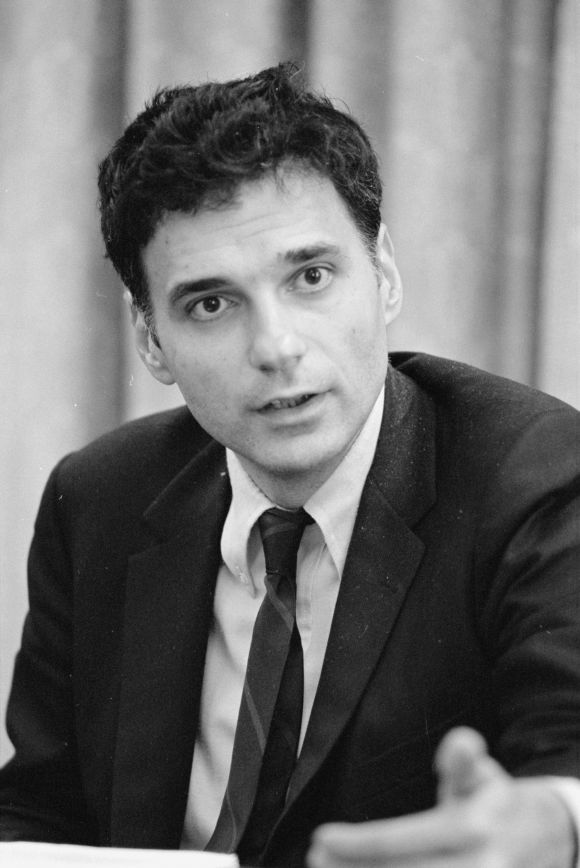
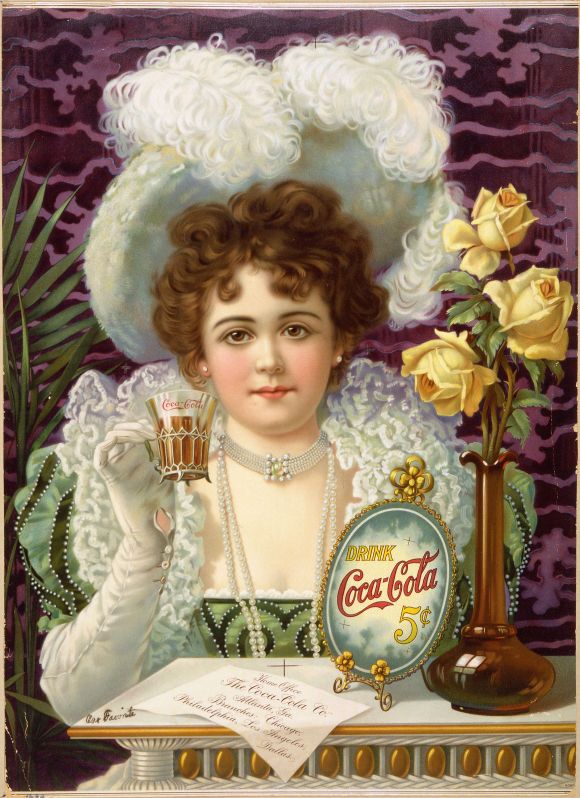


Comments